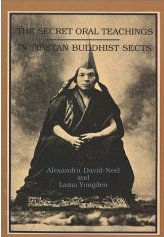 Secret Oral Teaching in Tibetan Buddhist Sects
Secret Oral Teaching in Tibetan Buddhist Sects

This is an account of the Madhyamika (Middle Way) school of Buddhism, a method of mediation and enlightenment that was developed by the great Indian teacher Nagarjuna. In a collaboration between the Frenchwoman Alexandra David-Neel and her friend, the Tibetan lama Aphur Yongden, these teaching are presented clearly and elegantly, intended for the layman who seeks a way to practice and experience the realization of oneness with all existence.
|
|
Louise Eugenie Alexandrine David (1868-1969) nasce a Saint-Mandé, vicino Parigi, da genitori anziani. Si applica allo studio del sanscrito e si interessa di buddismo fin da molto giovane, e un’eredità le permette di partire alla scoperta dei paesi che l’attirano: Ceylon, poi l’India. Tornata in Europa, decide di sfruttare la propria bella voce e si dedica al canto: il primo ingaggio importante lo ottiene dall’Opera di Hanoi nel 1895. Sposa Philippe Néel nel 1904 ma questo non la ferma, anzi: tra congressi e viaggi Alexandra non conosce riposo. Nel 1911 l’uscita di Buddismo di Budda coincide con la sua partenza per l’Asia. Philippe non rivedrà la moglie che nel 1926. Lei intanto si recherà in Nepal, Cina, Corea, Giappone, fino a entrare nel 1925, prima donna europea, a Lhasa, la città proibita agli stranieri. L’impresa è riportata dalla stampa di tutto il mondo, e Alexandra torna in Europa a raccogliere i frutti delle sue lunghe peregrinazioni. Da quel momento pubblica i suoi libri più famosi: Viaggio di una parigina a Lhasa, Mistici e maghi del Tibet, Nel paese dei briganti gentiluomini. Ci saranno altri viaggi e altri libri, come Magia d’amore e magia nera o Sotto nuvole di tempesta, nella vita di questa donna straordinaria, che morirà ultracentenaria e le cui ceneri verranno disperse nel Gange.
Alexandra David-Neel was born in 1868 in Paris. In her youth she wrote an incendiary anarchist treatise and was an acclaimed opera singer; then she decided to devote her life to exploration and the study of world religions, including Buddhist philosophy. She traveled extensively to in Central Asia and the Far East, where she learned a number of Asian languages, including Tibetan. In 1914, she met Lama Yongden, who became her adopted son, teacher, and companion. In 1923, at the age of fifty-five, she disguised herself as a pilgrim and journeyed to Tibet, where she was the first European woman to enter Lhasa, which was closed to foreigners at the time. In her late seventies, she settled in the south of France, where she lived until her death at 101 in 1969. |